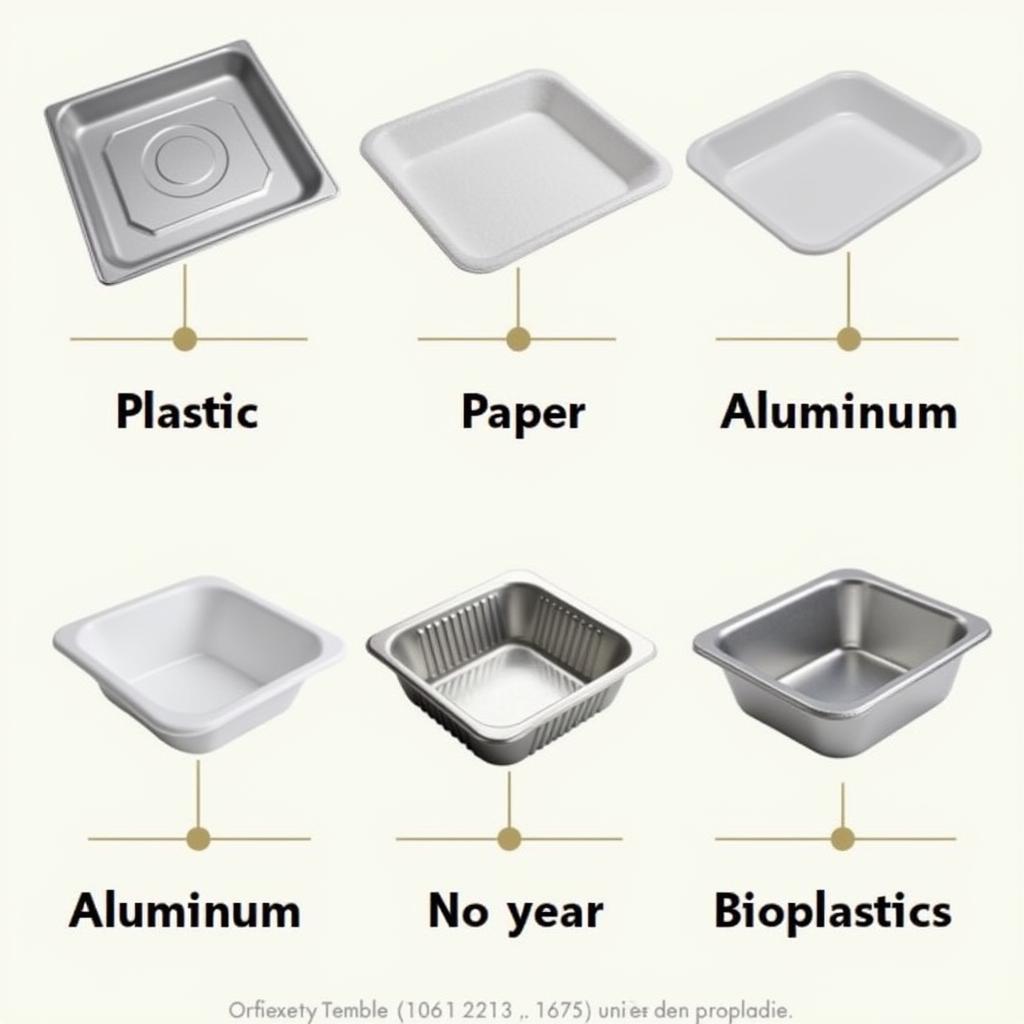Disposable Food Trays have become an indispensable part of modern life, offering convenience and portability for everything from quick lunches to large catered events. But with so many options available, choosing the right tray can be overwhelming. This guide dives deep into the world of disposable food trays, exploring the different materials, their benefits, and how to make sustainable choices. We’ll also examine how these trays fit into different scenarios and help you select the perfect tray for your specific needs. Let’s start by exploring the common materials used to make these essential items.
Understanding Disposable Food Tray Materials
Disposable food trays are made from a variety of materials, each offering unique benefits and drawbacks. Understanding these differences is crucial for making an informed choice. Let’s examine some of the most popular options.
Plastic Food Trays: A Balancing Act
Plastic disposable food trays are a ubiquitous choice, valued for their lightweight nature, durability, and affordability. They’re readily available in various sizes and shapes, making them adaptable for a wide range of food items. However, the environmental impact of plastic is a growing concern, and many are now looking for more sustainable alternatives.
Paper and Cardboard Trays: The Eco-Friendly Option
disposable paper food tray options offer a more environmentally friendly approach. They’re often made from recycled materials and are biodegradable, reducing their long-term impact on the planet. While durability might be a concern for certain foods, advancements in paper tray technology are continually improving their resilience.
Aluminum Food Trays: Strength and Recyclability
Aluminum cold food trays are a robust option, ideal for heavier food items and high-temperature applications like baking. Their recyclability also makes them an attractive choice for those seeking environmentally conscious solutions. Understanding the different aluminum food tray sizes is important for selecting the correct tray for your specific culinary needs.
 Disposable Food Tray Materials Comparison
Disposable Food Tray Materials Comparison
Choosing the Right Disposable Food Tray for Your Needs
The best disposable food tray depends entirely on your specific needs. Consider the type of food, the serving occasion, and your budget when making your selection.
What Type of Food Are You Serving?
For hot, greasy foods, aluminum or certain types of plastic might be the best choice. cardboard food packaging is suitable for drier items, while cold foods often do well in paper or plastic containers.
What’s the Occasion?
A casual picnic might call for simple paper trays, while a formal catered event might warrant more elegant and durable options. Consider the overall aesthetic and presentation you want to achieve.
What’s Your Budget?
While disposable trays are generally affordable, prices can vary depending on the material and quantity. Balancing cost-effectiveness with your other needs is important.
“Understanding the occasion is paramount,” explains renowned food stylist, Emily Carter. “The right tray can elevate the presentation of your food, creating a more enjoyable dining experience.”
The Future of Disposable Food Trays: Sustainability and Innovation
The future of disposable food trays lies in sustainable solutions. Bioplastics, compostable materials, and innovative recycling technologies are leading the way towards a more eco-friendly approach.
Bioplastics: A Promising Alternative
Bioplastics, derived from renewable resources like corn starch, offer a more sustainable option compared to traditional petroleum-based plastics.
Compostable Options: Reducing Landfill Waste
Compostable trays break down naturally, reducing landfill waste and enriching the soil. This is a significant step towards a circular economy.
Innovative Recycling Technologies: Closing the Loop
Advancements in recycling technologies are making it easier to recycle even complex materials, contributing to a more sustainable future.
“The focus is shifting towards closed-loop systems,” says Dr. David Miller, an expert in sustainable packaging. “We need to move away from a linear ‘take-make-dispose’ model and towards a system where materials are reused and recycled.”
Conclusion
Disposable food trays offer unparalleled convenience in our fast-paced world. By carefully considering the different materials, your specific needs, and the growing emphasis on sustainability, you can make informed choices that benefit both you and the environment. Choosing a silicone food storage container is an alternative for longer term storage needs. Ultimately, selecting the right disposable food tray is about finding the perfect balance between functionality, aesthetics, and environmental responsibility.
FAQ
- What are the most common materials for disposable food trays?
Plastic, paper, cardboard, aluminum, and bioplastics are common materials. - Are disposable food trays recyclable?
Some are, depending on the material and local recycling facilities. - What are bioplastics?
Bioplastics are made from renewable resources like corn starch, offering a more sustainable option. - Are there compostable disposable food trays available?
Yes, compostable trays break down naturally, reducing landfill waste. - What factors should I consider when choosing a disposable food tray?
Consider the type of food, the occasion, your budget, and your environmental preferences. - Where can I find sustainable disposable food trays?
Many suppliers now offer eco-friendly options, including bioplastics and compostable trays. - What are the advantages of using aluminum food trays?
Aluminum trays are sturdy, recyclable, and suitable for hot and heavy foods.
Common Scenarios:
- Large gatherings: Opt for bulk packs of sturdy disposable food trays.
- Food trucks: Choose leak-proof and easy-to-handle options.
- Kids’ parties: Colorful and fun disposable trays are a great choice.
Further Reading:
Check out our articles on disposable paper food tray and cold food trays for more specific information.
Need help with disposable food trays? Contact us at Phone Number: 02437655121, Email: minacones@gmail.com or visit us at 3PGH+8R9, ĐT70A, thôn Trung, Bắc Từ Liêm, Hà Nội, Việt Nam. We have a 24/7 customer service team.